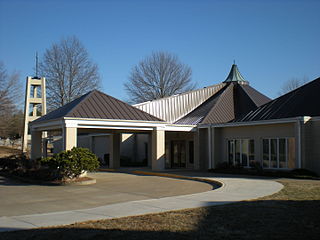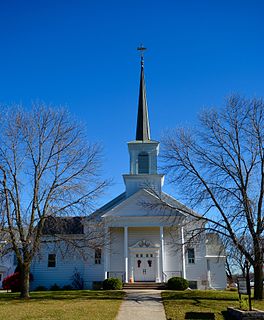
Calamus is a small town in Clinton County, Iowa, United States, located on the historical Lincoln Highway, which was the first transcontinental highway for automobiles across the U.S.. Calamus is the only town in Olive Township and had a population of 356 at the 2020 census, which was a 9.6% decrease from 2000. Calamus was named after Calamus Creek, which received its name from the great quantities of sweet flag growing in it, derived from the botanical name Acorus calamus, commonly called Sweet Flag or Calamus.

The Evangelical Lutheran Synod (ELS) is a US-based Protestant Christian denomination based in Mankato, Minnesota. It describes itself as a conservative, Confessional Lutheran body. The ELS has 130 congregations and has missions in Peru, Chile, India, South Korea, Ukraine, Czech Republic, and Latvia.

The American Lutheran Church (TALC) was a Christian Protestant denomination in the United States and Canada that existed from 1960 to 1987. Its headquarters were in Minneapolis, Minnesota. Upon its formation in 1960, The ALC designated Augsburg Publishing House, also located in Minneapolis, as the church publisher. The Lutheran Standard was the official magazine of The ALC.

The Evangelical Lutheran Synodical Conference of North America, often known simply as the Synodical Conference, was an association of Lutheran synods that professed a complete adherence to the Lutheran Confessions and doctrinal unity with each other. Founded in 1872, its membership fluctuated as various synods joined and left it. Due to doctrinal disagreements with the Lutheran Church–Missouri Synod (LCMS), the Evangelical Lutheran Synod (ELS) and the Wisconsin Evangelical Lutheran Synod (WELS) left the conference in 1963. It was dissolved in 1967 and the other remaining member, the Synod of Evangelical Lutheran Churches, merged into the LCMS in 1971.
The Evangelical Lutheran Church (ELC) was a Lutheran denomination that existed from 1917, when it was founded as the Norwegian Lutheran Church of America (NLCA), until 1960, when it joined two other church bodies to form the second American Lutheran Church.

Trinity Evangelical Lutheran Church is a Victorian Gothic-style Lutheran church built in Milwaukee, Wisconsin in 1878 - then claimed to be "the finest church edifice within the Missouri Synod." Today it is listed on the National Register of Historic Places and is a designated State Historic Site. The building was also declared a Milwaukee Landmark in 1967, and today is the oldest church associated with the Lutheran Church–Missouri Synod in the city.

The Swedish Evangelical Lutheran Church is a historic property in Anoka County, Minnesota. It is located at 2332 Swedish Drive in Ham Lake, Minnesota. The Late Victorian style church was built in 1872 to the design of architect Per August Gustafson. The church is listed on the National Register of Historic Places. The church is owned and maintained by the congregation of Our Savior's Lutheran Church of East Bethel, Minnesota and is also known as Our Saviors Lutheran Church of Ham Lake. Both churches are affiliated with the Evangelical Lutheran Church in America.

St. John's Evangelical Lutheran Church is a Gothic Revival-styled church built in 1889 in Milwaukee, Wisconsin by a congregation with German roots. In 1992, the church and associated buildings were listed on the National Register of Historic Places. It is also designated a Milwaukee Landmark.

St. Peter's Evangelical Lutheran Church, or Iglesia Luterana San Pedro, is a historic church complex located in the Walker's Point neighborhood of Milwaukee, Wisconsin. Its buildings are listed on the National Register of Historic Places.

Our Savior's Lutheran Church, is a Lutheran church located near the cities of Clifton and Cranfills Gap in the unincorporated community of Norse in Bosque County, Texas.

Ulrik Vilhelm Koren was a Norwegian-American author, theologian and church leader. A pioneer Lutheran minister, he played a significant role in the development of the spiritual and intellectual development of Norwegians in America. Ulrik Vilhelm Koren has been called the "patriarch of Norwegian American Lutherans."

The Gethsemane Evangelical Lutheran Church is a church located at 4461 Twenty-Eighth Street in Detroit, Michigan. It was designated a Michigan State Historic Site in 1980 and listed on the National Register of Historic Places in 1982. The building now houses the Motor City Missionary Baptist Church.

Gottlieb Bender Christiansen was an American Lutheran Minister who served as President at Trinity Seminary in Blair, Nebraska and was the first president of the United Danish Evangelical Lutheran Church.

Old East Paint Creek Lutheran Church is located north of Waterville, Iowa, United States. The church building was listed on the National Register of Historic Places in 1983.

Hanover Lutheran Church is a Lutheran congregation in Cape Girardeau, Missouri, that is a member of the Lutheran Church–Missouri Synod. The congregation's original organization came about in 1846 as a result of the heavy German immigration to Missouri in the 19th century. The church's name, "Hanover", was chosen to reflect the place of origin of the majority of its members, since many of the Germans who had settled northwest of the town of Cape Girardeau had immigrated from Hanover, Germany.

West Luther Valley Lutheran Church is a historic church built in 1871 in the Norwegian immigrant farm community southwest of Orfordville, Wisconsin on West Church Rd. In 1980 the church was added to the National Register of Historic Places as a remnant of that Norwegian community and for its association with the prominent Rev. Claus Clausen.

Grace Lutheran Church in Uniontown, Missouri is a member congregation of the Lutheran Church–Missouri Synod (LCMS).

The George Johnson House is an historic building located near Calamus, Iowa, United States. It was listed on the National Register of Historic Places in 2000.

St. John's Lutheran Church is a member congregation of the American Association of Lutheran Churches (AALC) in Pocahontas, Missouri.

West Paint Creek Synod Evangelical Lutheran Church and Cemetery is a historic building and site located northwest of Waterville, Iowa, United States. The church building and its adjacent cemetery were listed together on the National Register of Historic Places in 2019.























